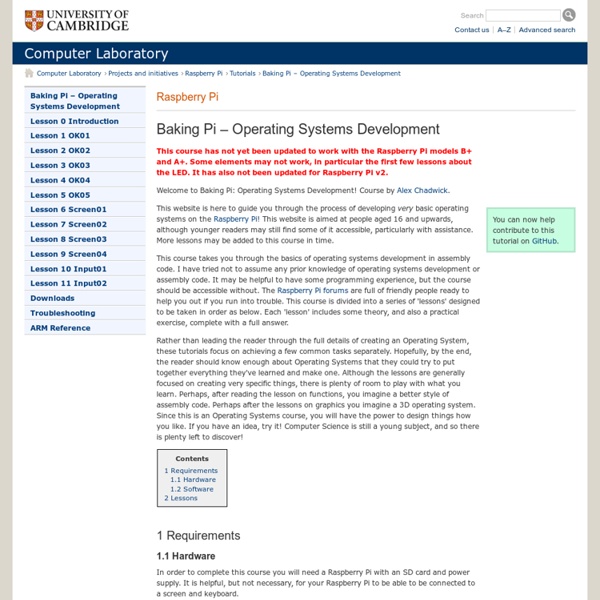How to install openelec on Raspberry pi with windows
How to install openelec on Raspberry pi with windows : 23-06-2012 How to install openELEC / xbmc on the Raspberry Pi with Windows. Today was a very exciting day in the SquirrelHosting office. Not only did the postman turn up early but in his bag was a treat. A small, little soldered board of love, that's right our Raspberry Pi had arrived! The version we had ordered had come with the 4GB SD card with Arch Linux installed. Want to buy an SD card with Openelec already installed? Step 1 : Download all the needed files You will need the following A copy of SDFormatter ( The binary version of win32diskimager from this location: An image of openELEC (Download the latest image file at the bottom) or official images here Step 2 : Format the Memory Card First thing to do is to format the memory card. That's it.
Cheat Sheets
Download All (.zip) Wall Posters (36" x 24") Interior Gateway Protocols v1.0 (1 page) Protocols v2.1 (2 pages) v2.1 (1 page) First Hop Redundancy v2.0 (1 page) v2.2 (2 pages) IPsec IPv4 Multicast IPv6 v2.0 (2 pages) v1.2 (1 page) v1.1 (1 page) Spanning Tree Applications Wireshark Display Filters scapy tcpdump Reference Common Ports IOS IPv4 Access Lists IPv4 Subnetting Syntax Markdown MediaWiki Technologies Frame Mode MPLS IOS Zone-Based Firewall QoS VLANs Voice VOIP Basics Miscellaneous Cisco IOS Versions Physical Terminations
Turtle Logo (programming language) for Kids - Home
Raspberry PiPod | Experiences with the Raspberry Pi micro computer
Xian has done a great job on this LEGO rover. It utilises Lego Power Functions and the Raspberry Pi and can be controlled via a web browser. He explains his build, with block diagrams and details on wiring and explains his use of the Navio board for controlling things. Nice job, Xian. Read about it here. The guys at Canadian company Roboteurs are currently running a Kickstarter campaign to fund their new stepper motor driver board – the SlushEngine. Controls up to 4 bi-polar stepper motorsMax 7A / motor9-35 V DC operating range1-128 microstepping capabilitiesIntegrated motion engine in stepper driver4 limit switch inputs4 general purpose industrial inputs4 general purpose industrial outputs (3A / 24V)8 additional logic level I/OThermistor temperature sensingUEXT expansion connectorRaspberry Pi fused power source The board is currently available to Earlybirds at $190 (Canadian Dollars) plus delivery, which works out at approximately £125 delivered.
Building Your Own Super Computer
Building Your Own Super - Building a Linux Cluster ( 4 ) Linux clusters are generally more common, robust, efficient and cost effective than Windows clusters. We will now look at the steps involved in building up a Linux cluster. Step 1 Install a Linux distribution (I am using Red Hat 7.1 and working with two Linux boxes) on each computer in your cluster. Usually, one node is designated as the master node (where you'll control the cluster, write and run programs, etc.) with all the other nodes used as computational slaves. Our cluster is private, so theoretically we could assign any valid IP address to our nodes as long as each has a unique value. If you already have Linux installed on each node in your cluster, then you don't have to make changes to your IP addresses or hostnames unless you want to. Finally, create identical user on each node. Step 2 We now need to configure rsh on each node in our cluster. Master DevArticle Slave DevArticle Master root Slave root tar zxfv mpich.tar.gz
Waterbear: Welcome
The Raspberry Pi Guy
On the 29th of February 2012 a credit card sized computer was released to the public... Not only did it kickstart my interests in programming, electronics and all things geeky but it also kindled the same passion in millions of others: affecting people of all different ages and abilities around the globe. What was this miraculous device? The Raspberry Pi. An affordable computer that anyone can buy and learn computing with. The Raspberry Pi will turn two years old in the upcoming months - that is two whole years of inspiration, projects and learning. All of the videos clips and images in this video are either my own or those that I found on YouTube and through Google images - it is all in the public eye already and I am dreadfully sorry if I have missed out something that you would have liked to have seen. I hope that you enjoy this video and join in with me in order to celebrate all things Pi! Here's to all of the years to come! MattThe Raspberry Pi Guy Sponsored by The Pi Hut!
The Ultimate List of Uses for Old Computers
Are you wondering what to do with that old computer? Well, I will start by skipping the usual… I will not talk about the obvious uses which you probably already know like: “Sell it on eBay”, “Cannibalize it”, “Give it to the Kids”, “Donate it”, “Recycle it” etc. If you wanted to do any of those you wouldn’t be reading this article in the first place, would you? Or other uses that are simply not practical for 99.9% of us… Like building a cluster… That is, if you have more than one old pc, and are prepared to spend more on electricity than what these computers are worth. I am going to give you real no-nonsense uses, which will save you money, make your life easier, and will be plain fun. I will provide you with links that will help you and not just leave you with empty-handed suggestions. File server: I would venture to say that this is easily the most popular use for an old computer now days. Build your own TiVo: Build your own SLINGBOX: Want to watch programs at work? Related Posts :
Cargo-Bot



